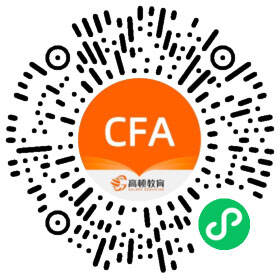距离2016年6月4日的CFA考试还剩下100天的时间了!各位在备考*9线的考生们,你们备考得顺利吗?高顿财经*9时间带来了研究院老师精心整理的CFA考试重点,帮助各位考生有效备考。
2016年CFA一级考纲变化内容分析:
1.财务报告及分析 Financial Reporting and Analysis
SS7,R23.Financial Reporting Mechanics
新增考点:
1、describe how business activities are classified for financial reporting purposes
SS8,R25.Understanding Income Statements
新增考点:
1、describe key aspects of the converged accounting standards issued by the International Accounting Standards Board and Financial Accounting Standards Board in May 2014;
SS9,Reading 29: Inventories
调整考点:
1、calculate and compare cost of sales, gross profit, and ending inventory using different inventory valuation methods and using perpetual and periodic inventory systems;
新增考点:
1、calculate and explain how inflation and deflation of inventory costs affect the financial statements and ratios of companies that use different inventory valuation methods;
2、explain LIFO reserve and LIFO liquidation and their effects on financial statements and ratios;
3、convert a company’s reported financial statements from LIFO to FIFO for purposes of comparison;
4、describe implications of valuing inventory at net realisable value for financial statements and ratios;
5、explain issues that analysts should consider when examining a company’s inventory disclosures and other sources of information;
6、calculate and compare ratios of companies, including companies that use different inventory methods;
7、analyze and compare the financial statements of companies, including companies that use different inventory methods.
删除考点:
1、calculate and compare cost of sales, gross profit, and ending inventory using perpetual
and periodic inventory systems;
2、compare cost of sales, ending inventory, and gross profit using different inventory valuation methods;
3、calculate and interpret ratios used to *uate inventory management.
SS9,Reading 30: Long-lived Assets
调整考点:
1、describe the different depreciation methods for property, plant, and equipment and calculate depreciation expense;
2、describe the different amortisation methods for intangible assets with finite lives and calculate amortisation expense;
3、describe how the choice of amortisation method and assumptions concerning useful life and residual value affect amortisation expense, financial statements, and ratios;
新增考点:
1、explain and *uate how capitalising versus expensing costs in the period in which they are incurred affects financial statements and ratios;
2、describe how the choice of depreciation method and assumptions concerning useful life and residual value affect depreciation expense, financial statements, and ratios;
3、explain and *uate how impairment, r*uation, and derecognition of property, plant, and equipment and intangible assets affect financial statements and ratios;
4、analyze and interpret financial statement disclosures regarding property, plant, and equipment and intangible assets;
5、explain and *uate how leasing rather than purchasing assets affects financial statements and ratios;
6、explain and *uate how finance leases and operating leases affect financial statements and ratios from the perspective of both the lessor and the lessee.
SS9,Reading 31: Income Taxes
调整考点:
1、explain recognition and measurement of current and deferred tax items;
2.投资组合管理 Portfoio Management
SS12,Reading 42. Risk Management: An Introduction
新增考点:
1、define risk management;
2、describe features of a risk management framework;
3、define risk governance and describe elements of effective risk governance;
4、explain how risk tolerance affects risk management;
5、describe risk budgeting and its role in risk governance;
6、identify financial and non-financial sources of risk and describe how they may interact;
7、describe methods for measuring and modifying risk exposures and factors to consider in choosing among the methods.
3.权益 Equity
SS14,Reading 50: Introduction to Industry and Company Analysis
调整考点:
1、explain how a company’s industry classification can be used to identify a potential “peer group” for equity valuation;
2、explain the effects of barriers to entry, industry concentration, industry capacity, and market share stability on pricing power and price competition;
3、describe industry life cycle models, classify an industry as to life cycle stage, and describe limitations of the life-cycle concept in forecasting industry performance;
SS14,Reading 51: Equity Valuation: Concepts and Basic Tools
调整考点:
1、explain the rationale for using price multiples to value equity, how the price to earnings multiple relates to fundamentals, and the use of multiples based on comparables;
4.固定收益 Fixed Incomne
SS15,Reading 53: Fixed-Income Markets: Issuance, Trading, and Funding
调整考点:
1、describe repurchase agreements (repos) and the risks associated with them.
SS15,Reading 55. Introduction to Asset-Backed Securities
调整考点:
1、describe securitization, including the parties involved in the process and the roles they play;
2、describe typical structures of securitizations, including credit tranching and time tranching;
3、describe types and characteristics of residential mortgage-backed securities, including mortgage pass-through securities and collateralized mortgage obligations, and explain the cash flows and risks for each type;
4、describe types and characteristics of non-mortgage asset-backed securities, including the cash flows and risks of each type;
5、describe collateralized debt obligations, including their cash flows and risks.
新增考点:
1、define prepayment risk and describe the prepayment risk of mortgage-backed securities;
SS16,Reading 57. Fundamentals of Credit Analysis
调整考点:
1、explain the four Cs (Capacity, Collateral, Covenants, and Character) of traditional credit analysis;
新增考点:
1、describe default probability and loss severity as components of credit risk;
5.另类投资 Alternatives
SS18,Reading 64.Introduction to Alternative Investments
调整考点:
1、describe issues in valuing and calculating returns on hedge funds, private equity, real estate, commodities, and infrastructure;
删除部分:
SS9,Reading 29: Inventories
1、calculate and compare cost of sales, gross profit, and ending inventory using perpetual and periodic inventory systems;
2、compare cost of sales, ending inventory, and gross profit using different inventory valuation methods;
3、calculate and interpret ratios used to *uate inventory management.
关于高顿财经:
高顿财经是国内*5CFA教育培训基地,拥有200余名CFA持证人讲师团队,每年培训超过5000名CFA华人考生,平均通过率超出全球平均通过率30%。
高顿财经秉承"终身财经教育"的理念,利用集团相关产品线,为学员构建了一个终身财经教育平台。高顿财经充分发挥财经教育核心资源优势,为学员提供可受益一生的后续教育,主题涵盖财经专业、职业发展以及个人修养等广泛内容,支持学员职业生涯的持续发展,打开职业上升通道,建立顶尖行业人脉圈。
看了上述分析,是否对自己CFA课程学习有所把握?高顿网校小编希望各位考试都可以根据自身的基础情况合理安排各科目的学习时间。

